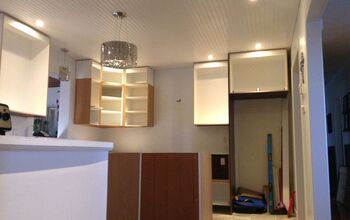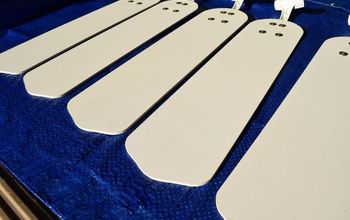How to remove a popcorn ceiling?

-
If it hasn't been painted over, it's fairly straight forward to spray it with water, then scrape it off. If you want a flat drywall ceiling, you may have to finish the seams before you sand and paint.
 Julies1949
on Aug 10, 2016
Helpful Reply
Julies1949
on Aug 10, 2016
Helpful Reply -
-
Once you start to scrap it off, it will generally come off in strips. You could just opt to cover it up with a thin styrofoam ceiling "tile" that is fairly economical.
 Ruidoso
on Aug 10, 2016
Helpful Reply
Ruidoso
on Aug 10, 2016
Helpful Reply -
-
How to Remove a Popcorn Textured or Acoustic Ceiling Check for Asbestos Take a small sample of the ceiling material and send it to an EPA certified testing lab before you begin. If your ceiling contains Asbestos, you will need to have a certified asbestos removal contractor do the job for you. Turn Electricity Off and Remove Light Fitting/s Since you’ll be using a lot of water in this project, first be sure to turn of the electricity and check it with a circuit tester. Remove all furniture and ceiling light fittings. Cover the Floor with Plastic Sheeting Tape small pieces of plastic over each electrical outlet and cover the floor with heavy duty plastic floor sheeting, extending it up the walls a foot or so. Cover the Walls with Plastic Sheeting Run painter’s tape along the upper edge of the walls then cover the entire wall with plastic sheeting, taping the top edge to the tape already there. Roll out a layer of resin paper on the floor. Wet the Ceiling Using a garden sprayer, wet the ceiling, working in 4 to 5 square feet areas at a time, wetting the ceiling thoroughly, but being careful not to over-wet it. Scrape the Popcorn Material off the Ceiling Round off the corners of a joint knife (to prevent gouges) and use it to scrape off the popcorn ceiling. If you run into any hard scraping areas, apply a little more water, wait and then try again. Unroll Second Layer of Resin Paper and Finish Scraping Unroll another layer of resin paper directly on top of ceiling debris and continue scraping ceiling. When all material has been scraped off, take down plastic sheeting from walls, roll up wet paper and plastic on floor and place all into a large garbage bag. Re-cover any Bare Joints Using Joint Compound and Joint Tape Mix joint compound in a tray and apply along the joint lines. Dip joint tape into water, squeeze of excess and use a putty knife to press the tape into the joint compound. Smooth off excess. Fill any Eroded Nail Holes Use two thin applications of joint compound to bring holes flush with the wallboard. Sand the Ceiling Use a sanding pad on the end of a long pole to sand off any high ridges. Finish Your Ceiling Fill any low spots with another coat or two of joint compound, sanding in between coats. Prime the ceiling using a primer that says “for wallboard”. Your ceiling is then ready for you to paint or texture as you like.
 William
on Aug 10, 2016
Helpful Reply
William
on Aug 10, 2016
Helpful Reply -
-
First , this job can be very messy so cover everything. A must of water usually loosens up the texture, then scrape with drywal knife. Careful to much water will soak the drywal paper. Scraping that can cause serious damage making you wish you'd never started. Then spackle sand, and prime as needed before painting. If the texture is already painted, good luck.
Southern Home Improvement, LLC on Aug 11, 2016
Helpful Reply -
-
When I did my kitchen reno. I attempted to remove it. Very long and dirty job. not recomended. You can hire someone to smoth it out, or do as I did and install pine boards over it. Much nicer finish.
 Sue Ryan
on Aug 11, 2016
Helpful Reply
Sue Ryan
on Aug 11, 2016
Helpful Reply -
-
Get a breathing mask and a lot of plastic sheeting, cover everything (including the floor) that you don't move out of the room; close any doors and hang the sheeting in open passage ways. spray a small amount of water (mist) on the ceiling and start scrapping with a scrapper or mud knife (6") will done. This is a very messy process usually. Don't scrape to hard or you will tear the sheet rock paper. If you do tear the paper mud will fix it.
 Michael Morrow
on Aug 11, 2016
Helpful Reply
Michael Morrow
on Aug 11, 2016
Helpful Reply -
-
the trick is to find the high point of the ceiling, as they are never perfectly even. My house was built in the 80 ies so it was sprayed on. I used tough and groove in my bathroom and 4 by 8 sheets in the kitchen. If your ceiling is very uneven I would suggest the single boards. They are thicker and more forgiving.
 Sue Ryan
on Aug 12, 2016
Sue Ryan
on Aug 12, 2016
 Helpful Reply
Helpful Reply -
-
If you're considering covering the ceiling (much easier) Armstrong makes a plank ceiling tile system that attaches to the ceiling by clips rather tha direct nailing or stapling to the existing surface. It covers minor imperfections and is easier to level. It takes some patience and practice, but comes in a variety of colors. Just right for a talented D.I.Yer.
Southern Home Improvement, LLC on Aug 13, 2016
Helpful Reply -
Related Discussions
Vinyl plank flooring vs pergo (laminate)
I currently have stinky dirty carpeting in my living room and I want to replace it with a durable flooring that can stand up to dogs and kids.
How to remove popcorn ceiling that has been painted?
Does having a paint over a popcorn ceiling change how I'd remove the popcorn ceiling?
How to apply peel and stick wallpaper?
I want to spruce up my walls with peel-and-stick wallpaper. Has anyone used this before and can advise me as to how to apply it properly?
How to stain wood floor?
I've heard staining is a good technique for updating floors. So how do I stain my wood floor?
Should I remove plaster and lathe or can I just remove plaster?
I have an 1882 Balloon construction house that has some pretty extensive plaster falling off of the lath. I know that the lath actually adds to the wall stability, a... See more
Anyone ever sand a linoleum floor to remove the design on top?
My kitchen floor is very solid linoleum squares with an ugly motif. In some places the scraping of a chair has rubbed off the orange design - which has inspired me. ... See more
